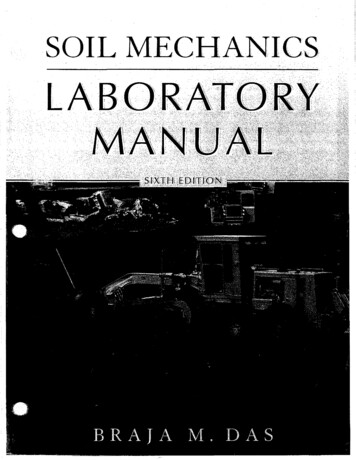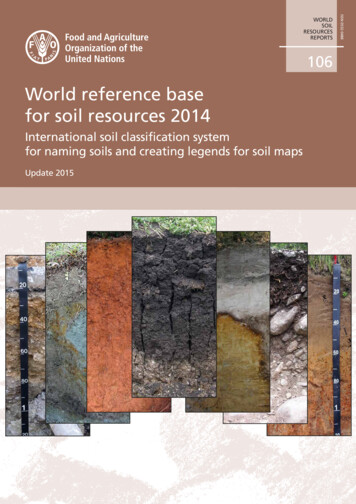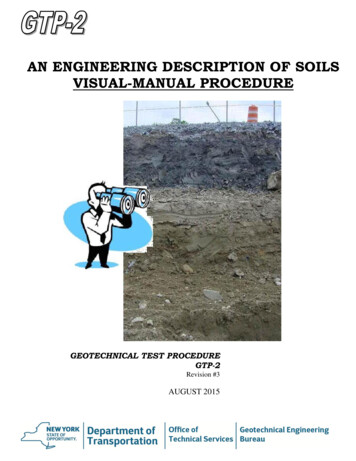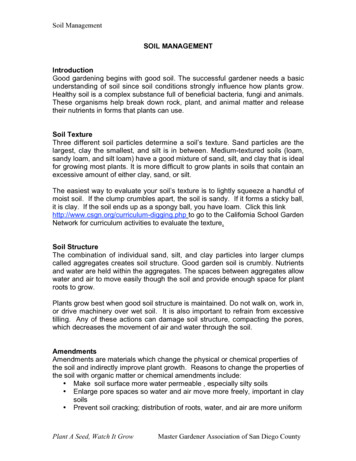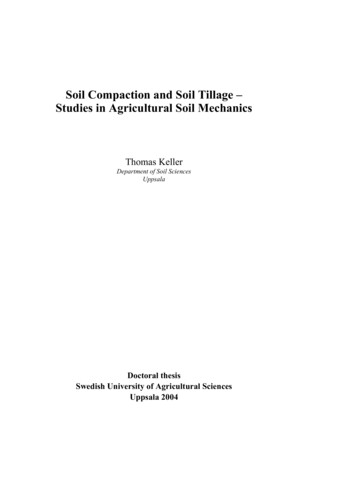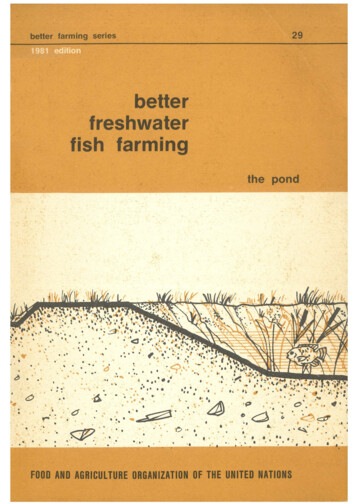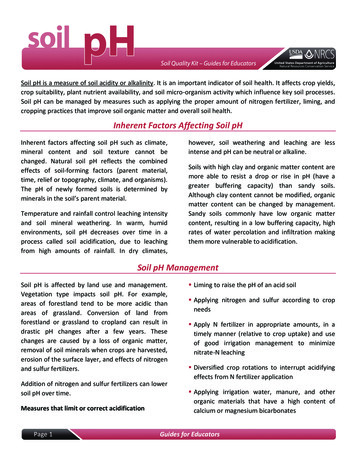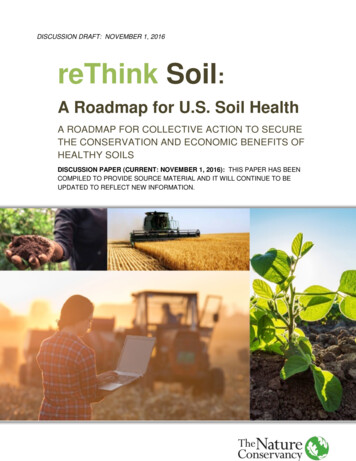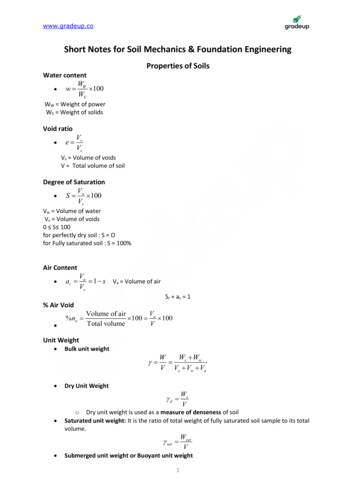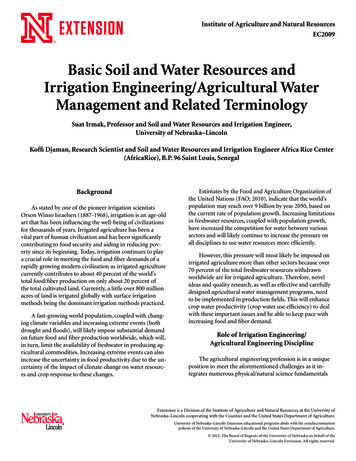
Transcription
Institute of Agriculture and Natural ResourcesEC2009Basic Soil and Water Resources andIrrigation Engineering/Agricultural WaterManagement and Related TerminologySuat Irmak, Professor and Soil and Water Resources and Irrigation Engineer,University of Nebraska–LincolnKoffi Djaman, Research Scientist and Soil and Water Resources and Irrigation Engineer Africa Rice Center(AfricaRice), B.P. 96 Saint Louis, SenegalBackgroundAs stated by one of the pioneer irrigation scientistsOrson Winso Israelsen (1887-1968), irrigation is an age-oldart that has been influencing the well-being of civilizationsfor thousands of years. Irrigated agriculture has been avital part of human civilization and has been significantlycontributing to food security and aiding in reducing poverty since its beginning. Today, irrigation continues to playa crucial role in meeting the food and fiber demands of arapidly growing modern civilization as irrigated agriculturecurrently contributes to about 40 percent of the world'stotal food/fiber production on only about 20 percent ofthe total cultivated land. Currently, a little over 800 millionacres of land is irrigated globally with surface irrigationmethods being the dominant irrigation methods practiced.A fast-growing world population, coupled with changing climate variables and increasing extreme events (bothdrought and floods), will likely impose substantial demandon future food and fiber production worldwide, which will,in turn, limit the availability of freshwater in producing agricultural commodities. Increasing extreme events can alsoincrease the uncertainty in food productivity due to the uncertainty of the impact of climate change on water resources and crop response to these changes.Estimates by the Food and Agriculture Organization ofthe United Nations (FAO; 2010), indicate that the world’spopulation may reach over 9 billion by year 2050, based onthe current rate of population growth. Increasing limitationsin freshwater resources, coupled with population growth,have increased the competition for water between varioussectors and will likely continue to increase the pressure onall disciplines to use water resources more efficiently.However, this pressure will most likely be imposed onirrigated agriculture more than other sectors because over70 percent of the total freshwater resources withdrawnworldwide are for irrigated agriculture. Therefore, novelideas and quality research, as well as effective and carefullydesigned agricultural water management programs, needto be implemented in production fields. This will enhancecrop water productivity (crop water use efficiency) to dealwith these important issues and be able to keep pace withincreasing food and fiber demand.Role of Irrigation Engineering/Agricultural Engineering DisciplineThe agricultural engineering profession is in a uniqueposition to meet the aforementioned challenges as it integrates numerous physical/natural science fundamentalsExtension is a Division of the Institute of Agriculture and Natural Resources at the University ofNebraska–Lincoln cooperating with the Counties and the United States Department of Agriculture.University of Nebraska–Lincoln Extension educational programs abide with the nondiscriminationpolicies of the University of Nebraska–Lincoln and the United States Department of Agriculture. 2015, The Board of Regents of the University of Nebraska on behalf of theUniversity of Nebraska–Lincoln Extension. All rights reserved.
to solve agriculture and natural systems/resources-relatedproblems, including water management/irrigation engineering and crop production. In this process, an agricultural/irrigation engineer understands the complex natureof microclimate, climate, soil, water, plant physiology, andplant biophysical characteristics.Perhaps more important, agricultural/irrigation engineers understand the interactions of these variables, agricultural machinery, as well as associated design, operation, andmanagement principles related to agricultural structures/infrastructures. This includes irrigation systems, pumps,motor/engines, canals, etc. Control systems, data acquisition, advanced sensors and instrumentation are part of therequired background to achieve this integration.All these processes require a solid engineering background, including background in hydraulics, fluid mechanics, statics, dynamics, etc. The irrigation engineeringprofession is equipped with the expertise and scientific andengineering background to synthesize the knowledge andskills from several different disciplines to develop practicalsolutions for solving real-world problems, which is a verychallenging task to accomplish.To be effective and relevant, an agricultural engineermust be ahead of the curve related to technological developments as well as their implementation in productionfields. This requires advanced understanding of soil-water-plant-atmosphere relationships in relation to developingbest management practices of irrigated (and dryland) cropping systems to enhance water productivity. Accomplishingall these tasks also requires advanced understanding of engineering infrastructures, design capacity vs. water requirements, and evapotranspiration relationships to be able toaccurately quantify and interpret the dynamic relationshipsbetween all these components of complex agricultural andnatural systems. Thus, the irrigation engineering profession historically has been the core profession that is wellequipped to tackle many aspects of issues related to waterresources, irrigation management and crop productivity.As the irrigation engineering field itself has evolvedover time, especially within the last five to six decades, basicterminologies used in irrigation and related fields have alsoundergone some significant changes. Similarly, commonunderstanding or definition of irrigation and related terminology can aid in better communication between scientists,Extension personnel, producers, practitioners, and otherprofessionals. The primary objective of this publicationis to define terminology commonly used by the irrigationscience community as well as by irrigation practitioners,irrigation system designers, producers, water managementand regulatory agency personnel, and other professionalsinvolved in irrigated agriculture.2TerminologyThe definitions and, in some cases, their brief descriptions/explanations, of the terminology are presented inalphabetical order rather than grouping them based ontopical areas. Most of the units are presented in Englishunits, but the units of some of the variables are presentedas Metric Units (The International System of Units; SI),because they are universally accepted and often used asMetric Units in theoretical and practical applications. Insome cases, the sources/references used are not listed inassociated specific text, but are provided in the Referencessection. The terminologies included in this publication, inalphabetical order, are:Bulk DensityCenter Pivot IrrigationCrop Water Use Efficiency (Crop Water Productivity)Deep PercolationDeficit IrrigationDrip (Trickle) IrrigationEffective Rainfall (Precipitation)EvaporationEvapotranspiration (Crop Water Use, Latent Heat Flux)Field CapacityGravitational WaterHydraulic ConductivityHygroscopic WaterHysteresis (desorption and sorption)InfiltrationIrrigationIrrigation Application UniformityIrrigation EfficiencyIrrigation RequirementIrrigation Water Use EfficiencyLeachingLeaching RequirementLimited IrrigationManagement Allowable Deficit or Depletion (MAD)MicroirrigationPermeabilityPermanent Wilting Point (PWP)Readily (Easily) Available Water (RAW)Root ZoneRunoffRun-onSaturation PointSeepageSensitivity to Water StressSoil AggregatesSoil Matric PotentialSoil PorositySoil RespirationSoil Sealing (Crusting)Soil StructureSoil Texture The Board of Regents of the University of Nebraska. All rights reserved.
Soil Water ContentSoil Water DeficitSubirrigationSurface IrrigationSurge IrrigationTailwaterTranspirationWater Conveyance EfficiencyWater Holding Capacity (or Available Water –Bulk Density: The ratio of the weight of a given volume of dry soil, including air space, to the weight of anequal volume of water. This ratio is also known as dry bulkdensity or volume weight. In other words, it is the ratio ofthe soil mass to the bulk or macroscopic volume of soilparticles plus pore spaces in a soil sample. It is usually expressed as lb/ft3 or gr/cm3 (1 gr/cm3 62.43 lb/ft3). Themass is usually determined after drying to constant weightat 105 C (221 F), and the volume is that of the soil sampleas taken in the field.(Span)Radius of theirrigated area under the pivotSystem capacity system flow rate (gpm) / irrigated area (acre)Figure 1: S ome of the basic components of a center pivot irrigationsystem in the field.Typical or average bulk density values of agriculturalsoils vary substantially, depending on many factors, but typical values are: 1.45 gr/cm3 (90.52 lb/ft3) or greater for sandysoils; 1.40-1.45 gr/cm3 (87.4 – 90.52 lb/ft3) for sandy-loamsoils; 1.38 gr/cm3 (86.15 lb/ft3) or greater for loam soils;1.25-1.35 gr/cm3 (78.03 – 84.28 lb/ft3) for silt-loam soils;1.30-1.35 gr/cm3 (81.16 – 84.28 lb/ft3) for clay-loam soils;and 1.10-1.20 gr/cm3 (68.67 – 74.91 lb/ft3) for clay soils.Bulk density varies with structural conditions of thesoil and can be used as an indicator of soil structure. Thesebulk density values change substantially with the soil textural properties. Two soil types may belong to the same soilseries (e.g., silt-loam), but can have different bulk densities.For example, one soil type may have 20 percent sand and20 percent clay with a bulk density of 1.37 gr/cm3 (85.53lb/ft3), while the other soil that consists of 20 percent sandand 10 percent clay may have a bulk density of about 1.40gr/cm3 (87.4 lb/ft3); however, both soils are classified as siltloam soils.Bulk density will also change with the soil depth. It usually increases with depth and is also impacted substantiallyby soil management practices, including irrigation practices,tillage practices, within-field traffic (compaction), organicmatter content, etc. Decreases in organic matter contentusually result in increased bulk density in agricultural soils(Hillel, 1998).Center Pivot Irrigation: A method of irrigation inwhich the system/machine rotates around a pivot point andcrops are irrigated with impact sprinklers or drop nozzles.A typical center pivot irrigation system and its main components are presented in Figures 1 and 2. An area centeredon the pivot point is irrigated, creating a circular pattern in The Board of Regents of the University of Nebraska. All rights reserved.Figure 2: A nine-span center pivot system operating in a soybeanfield in southwestern Nebraska in an early summer morning to assess the uniformity of the water application.crops. Most center pivots were initially water-powered butnow most are propelled by electricity and diesel motors.Natural gas, propane, and a limited number of ethanolfuel-based engines are also used. The entire main pipelineof the center pivot system is rotated at the same time veryslowly around the pivot point in the center of the field bymotors (usually 1 HP each) at each tower (span).In some cases, towers move incrementally — one towermoves forward for a certain distance and stops and the nexttower moves the same distance and stops. This process is repeated for each tower (each tower moves individually).In some center pivot systems, the entire system (allspans) moves simultaneously and continuously. Sprinklersor nozzles, which are the system components designed todistribute the water to the field uniformly as the center pivot rotates, are mounted on the main system delivery pipe(span).3
Center pivot systems are available to cover square fieldsranging in size, usually 80 to 260 acres (32.4 to 105 hectare)or larger. Total system capacity usually ranges from 400 to1,200 gpm (90.85 to 272.55 m3/hour) or greater. Lateral(linear)-move systems are available to irrigate rectanglefields. Lateral-move systems travel back and forth in thesame horizontal direction rather than in a circular direction. The speed of the center pivot is a function of waterapplication rate.Center pivots function best in flat terrains, which results in minimal surface runoff when the pivot is operatedproperly and effective irrigation management is practiced.The discharge rate of the sprinklers/nozzles should besmaller than the soil permeability to enable irrigation waterinfiltration into the soil to prevent surface runoff during theirrigation.Center pivots can also operate effectively in sloping/rolling fields. When properly designed and managed, centerpivots are more efficient in terms of water delivery and uniformity than surface irrigation methods. In some regions ofthe world, this advantage has resulted in increased irrigatedacreage and enhanced crop yield productivity per unit ofwater applied.In center pivot irrigation systems, the nozzle or sprinkler size is tapered as the flow rate increases gradually fromthe first span (from the pivot point) to the outer span tocompensate for the increased area to be irrigated per revolution of the center pivot. Advances in nozzle technology haveenabled these systems to minimize water losses from driftevaporation during the irrigation (e.g., low drift nozzles).The typical center pivot system has seven spans eachwith a typical span length of 160-190 ft (48.8 – 57.9 m).Most center pivots are designed to deliver 1.0-1.25 inch(25.4 – 32 mm) of irrigation water per revolution, althoughthis amount can be easily adjusted with the center pivotspeed, depending on the system design capacity. The spanlength can range from 100-250 ft (32 – 76 m). The area under each span that is irrigated increases substantially fromthe pivot point toward the end tower (span). The area undereach span (based on various span lengths) and dischargerates are presented in Table 1.When a square field is irrigated using a center pivotsystem, the corners of the field can be irrigated using cornersystems or end-guns. When a square-shaped field is irrigated with a center pivot without a corner system, about 21percent of the total field area is not irrigated. Fertilizers andother nutrients can be applied via a center pivot irrigationsystem (fertigation). Chemicals can also be delivered at anytime during the growing seasons using the center pivots(chemigation).Crop Water Use Efficiency (Crop Water Productivity): The irrigation effectiveness in terms of crop yield withrespect to water use. It is defined as the ratio of the mass ofeconomic yield or biomass produced per unit of water usedin evapotranspiration (ET) and it is expressed as:CWUE (Yi – Yd) / (ETi – ETd)CWUE crop water use efficiency (bu/acre-inch) yield of irrigated crop (bu/acre)YiYd yield for an equivalent rainfed (dryland) crop(bu/acre)ETi ET for irrigated crop (inch)ETd ET for rainfed (dryland) crop (inch)The CWUE equation represents the ratio of the yieldincrease to the increase of ET under irrigation, relative torainfed or dryland treatment. Crop water use efficiencyhas units of production per unit of water used as ET. Unitstypically used are ton per acre-inch, pound per acre-inch, orbushels per acre-inch.Table 1: I rrigated field area and discharge rate for a typical center pivot irrigation system (Adopted from the Nebraska Extension Publication“Center Pivot Irrigation Management Handbook,” 2011).Span number(starting from pivot point)Cumulative spanlength (ft)Cumulative areaunder the span (acre)Cumulative dischargefrom each span 41276108084.115671260114.4184Including overhang1310123.756TOTAL4749 The Board of Regents of the University of Nebraska. All rights reserved.
CWUE values can vary substantially for the same cropfrom one field to another in the same region and betweenthe regions due to differences in management practices. Italso has substantial inter-annual variability due to climaticvariables impacts on yield and evapotranspiration. In Nebraska, on a statewide average basis, irrigated maize CWUEranges from 5.4 bu/in to 8.5 bu/in with a statewide averagevalue of 7.04 bu/in of ET. Soybean CWUE ranges from 2.1bu/in to 3.4 bu/in with a statewide average value of 2.09 bu/in of ET.Deep Percolation: The amount of water that drainsvertically below the crop root zone. While in an agriculturalfield, deep percolation may be considered as a loss of waterbelow the root zone; in other water balance categories itmay be considered a source of water that recharges groundwater/aquifer and is not considered a loss. Deep percolationrates vary with the type of irrigation system; irrigationfrequency and application amount in each irrigation event;precipitation duration and rate; initial soil water contentbefore soil wetting with irrigation and/or precipitation;crop type; crop water use rate; field slope; crop rootingdepth; soil textural and physical characteristics, includinginfiltration rate and conductivity; management practices’and other factors. Since the crop’s root zone varies due tomany factors, including crop root characteristics, climaticcondition, and management practices, the amount of deeppercolation calculated for different crop types in the samesoil type can vary.Deficit Irrigation: An irrigation method that increasesor optimizes water use efficiency by eliminating irrigationevents during the less sensitive crop growth stages that mayhave less impact on crop yield/productivity than other moresensitive stages. In many cases, it is not feasible to practiceirrigation to meet the full crop water requirement due tolimitations in a variety of factors, including availability ofwater, water withdrawal allocations, high crop water userates, limitations in irrigation system capacity, soil textural properties (e.g., coarse-textured soils that have limitedwater-holding capacity), water quality issues, and otherreasons. Agronomic measures such as reduced or no-tillpractices, mulching, and the use of anti-transpirants (cropregulators that reduce transpiration rate via stalling leafstomata) can reduce irrigation requirements. In such cases,practicing deficit irrigation can increase crop water productivity (crop water use efficiency).Under water-limiting conditions, deficit irrigation ispracticed to apply water at certain crop growth and development stages, which exposes crops to certain (predetermined) levels of water stress during either a particulargrowth or development stage or throughout the irrigationperiod during the growing season.The magnitude of water stress sensitivity varies substantially among different crops and their corresponding The Board of Regents of the University of Nebraska. All rights reserved.growth stages. For example, during the vegetative growthstage, maize grain yield is less affected by water stress thanduring the more sensitive tasseling, silking, and grain-fillstages. Soybean crop yield decreases more when waterdeficit occurs during flowering and pod formation/development stages than during vegetative growth. Thus, maizeand soybean crops can be exposed to a certain level of waterstress in the vegetative stage rather than the more sensitivereproductive stages.Even though deficit irrigation, in most cases, will resultin enhanced crop water productivity (because less water isapplied than the full-irrigation requirement), it may resultin a yield reduction due to a reduction in transpiration andevapotranspiration rates as a result of leaf stomata response(closure) to water stress. In practice, deficit irrigation mostlikely results in enhanced crop water productivity due toless water being applied and losses through evaporation,runoff and deep percolation are minimized. Consequently,decrease in transpiration and evapotranspiration rate dueto leaf stomata closure to water stress usually results inyield reduction.The magnitude of the yield reduction will depend onthe crop type, the crop’s genetic background, the severity ofwater stress, the timing of the stress during the growing season, climatic conditions, and other factors such as soil textural and physical properties. Soil textural properties playan important role because they dictate soil water storage capacity. Thus, in deficit irrigation, the water holding capacityof the soil must be taken into account.In sandy soils, plants may experience water stressvery fast under deficit irrigation, whereas plants grown onfine-textured (e.g., silt-loam) soils may have adequate timeto adjust to low soil water status until the next irrigationand/or rainfall. Therefore, the success of deficit irrigationmanagement is usually greater in fine-textured soils than incoarse-textured soils in the same climatic conditions. Also,the success of deficit irrigation is greater in humid and subhumid climates where precipitation usually supplementsadditional water and could coincide with the critical growthstage when water is needed, compared with arid and semiarid climates.Drip (Trickle) Irrigation: A form of the microirrigation method, drip irrigation can be either surface drip orsubsurface drip. Subsurface drip irrigation (SDI) supplieswater directly to the crop root zone via polyethylene driplines and emitters. Black polyethylene is usually used toprevent algae growth inside the drip line. Irrigation laterals are buried below the soil surface, typically between 8to 20 inches, depending on the soil and crop type, climate,management practices, and other factors. In sandy or sandyloam soils, drip lines should be buried shallower than thosein more finely textured soils (e.g., silt loam, clay loam) andthe between row spacing should be narrower than those in5
heavier textured soils to ensure adequate access of water bythe crop roots. The operational characteristics of the surfacedrip irrigation are essentially the same as SDI, but the driplines are placed on the surface.Burying drip lines underground eliminates surfacesoil evaporation due to irrigation. If properly designed andmanaged, SDI system eliminates wind drift and surfacerunoff, reduces surface soil evaporation, minimizes waterand nutrient loss due to deep percolation and enables “precision-feeding” the crop through effective delivery of irrigation water and nutrients directly to the crop root zone atany point during the growing season.The “precision-fed” characteristic of the SDI systemhas great potential to minimize or eliminate the movementof water and nutrients below the crop root zone when thesystem is properly managed. With SDI, the irrigation wateris filtered at the filter and control station before entering thefield through the drip laterals.Even though drip and trickle irrigation are used interchangeably, the American Society of Agricultural EngineersPractice EP405 makes a technical distinction that trickle irrigation includes water application systems with greater discharge rates than those with drip systems. To be classified asa drip irrigation system, point source emitters should havedischarge rate of 3 gph or lesser and line source emitters lessthan 0.02 gal/hr/ft of irrigation lateral. Trickle irrigation isalso considered as a form of microirrigation.Compared to other irrigation systems, SDI is the mostefficient way to deliver irrigation water to the crop rootzone with irrigation efficiency usually greater than 95 percent. The lateral and vertical wetting area of the soil takesplace inside the soil profile only to a certain extent as afunction of soil physical properties and system flow rate,frequency of irrigation applications, and other factors. Thewater is delivered in small amounts using emitters that aredesigned to provide low flow rate (discharge) at the atmospheric pressure head at specific discharge points, in spite ofsystem pressure that is maintained at certain levels, usuallybetween 18-22 psi for SDI and lower pressures for surfacedrip. With a surface drip irrigation system, only a fractionof the soil surface (e.g., 10-50 percent) is wetted, whichhelps reduce/minimize soil surface evaporation losses.The bubbler irrigation method, which is the applicationof water to the soil surface as a small stream or form offountain, also is included in the trickle irrigation category.Discharge rates with bubblers are generally greater thanthose for drip irrigation, but less than 1 gpm (3.78 L/min).The soil surface evaporation losses are usually lower with thesubsurface drip irrigation than the surface drip irrigation.6Effective Rainfall (Precipitation): The portion of thetotal annual or seasonal rainfall, or a portion of any givenprecipitation event, which is used directly and/or indirectlyfor crop production. Effective rainfall usually excludes irrigation and/or rainfall water intercepted by green and/or dryvegetation/canopy, water that is lost by evaporation fromthe soil surface.Effective rainfall is sometimes defined as the total rainfall minus evapotranspiration. For crop production, therainfall should infiltrate the soil. Therefore, effective rainfallis sometimes defined as the amount of total rainfall (precipitation) that infiltrates the soil profile.Even though precipitation and rainfall are used interchangeably in many cases, precipitation includes all formsof water falling to the surface, including rain, snow, sleet,and hail, whereas rainfall usually refers to the liquid water(rain). The effectiveness of rainfall is influenced by manyfactors, including land/soil physical and chemical characteristics (soil type, slope, residue cover, and other physicaland chemical characteristics that influence infiltration rate,etc.); other meteorological conditions (temperature, solarradiation, and wind speed); rainfall characteristics (rainfall duration, rate); soil-water characteristics, soil and cropmanagement practices, drainage characteristics, and cropcharacteristics, etc.Effective rainfall can vary substantially for differentland cover and land use types, and the interception of rainfall by vegetation/canopy can be a considerable fraction ofprecipitation, as much as 15-40 percent in forest canopies.In agricultural fields, maize, soybean, and similar crop canopies can intercept 0.08 inch to 0.16 inch of precipitation,sprinkler irrigation water for precipitation, or irrigationevents greater than 0.5-0.6 inch.Evaporation: A transformation of any given substance(i.e., water) from liquid form to vapor (water vapor) form. Ina solid (frozen) water case, the evaporation is known as sublimation (i.e., convergence of ice to water vapor). Evaporationcan occur from the soil surface, free water surfaces (lakes,ponds, rivers), surface irrigated fields, parks, buildings — essentially from any surface, including crop surfaces as a resultof intercepted water from irrigation and/or precipitation.All these evaporation losses are essential componentsof the hydrologic cycle. In an agricultural crop productionsetting, soil evaporation can be a significant fraction ofseasonal total crop evapotranspiration, depending on soil,crop, and irrigation management as well as climatic characteristics. Reduced or no-till practices, as well as early planting and narrower row spacing that results in faster canopyclosure, can reduce evaporation losses. In the hot and windyconditions of the Midwestern region, soil evaporation canbe up to 30-35 percent of seasonal total evapotranspirationof agronomic croplands. The Board of Regents of the University of Nebraska. All rights reserved.
Irrigation management, including irrigation method,irrigation frequency, and application amounts, can havesubstantial influence on soil evaporation rates. In subsurface drip irrigation, for example, the soil surface can beextremely dry (in the absence of precipitation), and waterstatus can be very close to or at wilting point, crops do notexperience any water stress since the roots have ample access to water in deeper layers from drip lines that are buriedunderground. Therefore, surface soil evaporation from irrigation is minimal.In surface irrigation methods, the surface evaporationoccurs primarily from free surface irrigation water, and itis not a significant fraction of total water applied (i.e., 1-3percent). Evaporation losses from sprinklers/spray nozzlesare a strong function of nozzle/droplet characteristics (type,size, and pressure), air temperature, wind speed, relativehumidity, and vapor pressure deficit during the irrigation.Such losses can range from 2 to 10 percent (or more duringvery hot and windy conditions) of the total amount of water discharged by the sprinklers.Evapotranspiration (Crop Water Use, Latent HeatFlux): The water loss into the atmosphere, which is the sumof evaporation from any surface plus transpiration fromgreen vegetation (takes place in the form of very small watervapor particles through plant stomata). In practice, separation of evaporation and transpiration is a very difficult task;therefore, these two terms are often combined into the term“evapotranspiration.”In most cases, evapotranspiration is the largest component of the hydrologic cycle in arid, semiarid and subhumidregions. In humid regions, the precipitation amount usuallyexceeds the evapotranspiration amount. Therefore, accuratequantification of evapotranspiration is critical for accurate/complete water balance analyses, and current and futurewater use projections on a field, a watershed, a region, or aglobal scale.Field Capacity: Represents the practical upper limit ofplant-available water in the soil. Field capacity is one of themost critical soil physical characteristics and plays a vitalrole in soil-water movement, hydrology, plant physiologicalresponses, irrigation/water management, soil moisture dynamics, crop water uptake, evapotranspiration, runoff, deeppercolation, and many other processes in agriculture andnatural resources settings. It drives many s
Center Pivot Irrigation: A method of irrigation in which the system/machine rotates around a pivot point and crops are irrigated with impact sprinklers or drop nozzles. A typical center pivot irrigation system and its main com-ponents are presented in Figures 1 and 2. An area centered on the pivot point is irrigated, creating a circular pattern in


